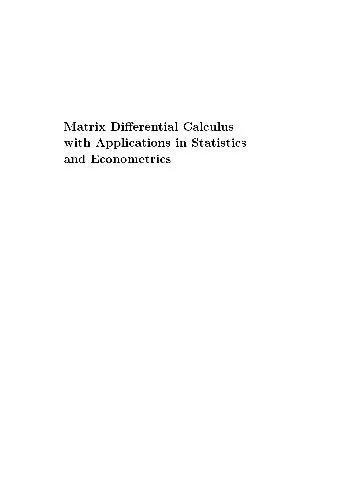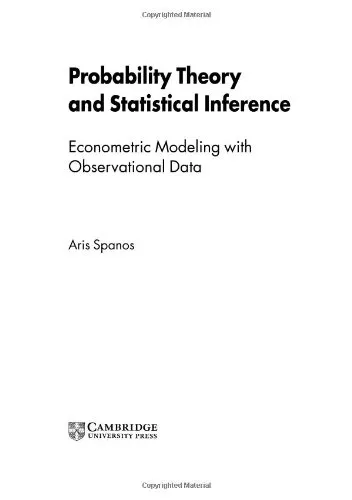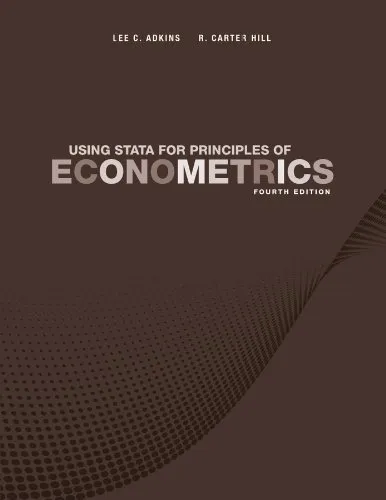Principles of Neural Model Identification, Selection and Adequacy: With Applications to Financial Econometrics
3.8
بر اساس نظر کاربران

شما میتونید سوالاتتون در باره کتاب رو از هوش مصنوعیش بعد از ورود بپرسید
هر دانلود یا پرسش از هوش مصنوعی 2 امتیاز لازم دارد، برای بدست آوردن امتیاز رایگان، به صفحه ی راهنمای امتیازات سر بزنید و یک سری کار ارزشمند انجام بدینکتاب های مرتبط:
معرفی کتاب "Principles of Neural Model Identification, Selection and Adequacy: With Applications to Financial Econometrics"
کتاب Principles of Neural Model Identification, Selection and Adequacy: With Applications to Financial Econometrics نوشته "Achilleas Zapranis" و "Apostolos-Paul N. Refenes"، اثری جامع و علمی است که به بررسی اصول شناسایی، انتخاب و ارزیابی مدلهای Neural Networks در زمینه اقتصاد مالی میپردازد. این کتاب به عنوان مرجعی قابل اعتماد، هم برای پژوهشگران و اساتید دانشگاه و هم برای متخصصان مالی و دانشجویان علاقهمند به یادگیری روشهای کاربردی Neural Networks مناسب است. در ادامه، به طور جامع به بررسی محتوا و اهمیت این کتاب میپردازیم.
خلاصهای دقیق از کتاب
این کتاب مفاهیم پایه و روششناختی شناخته شدهای را برای شناسایی و ارزیابی مدلهای Neural Networks معرفی میکند. این مدلها ابزار قدرتمندی برای تحلیل دادههای پیچیده در حوزههایی چون اقتصاد مالی، مدیریت ریسک و پیشبینی مالی فراهم میآورند. نویسندگان کتاب از ترکیبی از نظریه و عمل استفاده کردهاند تا بتوانند کاربردهای عملی Neural Networks را با تکیه بر شواهد علمی ارائه کنند.
ساختار کتاب به نحوی طراحی شده است که ابتدا مبانی ریاضی و آماری مرتبط با Neural Networks را معرفی کند. سپس در فصول بعدی، مراحل شناسایی مدل، انتخاب مدل بهینه و ارزیابی کفایت مدل شرح داده میشوند. در نهایت نیز مثالهای عملی گستردهای از کاربردهای Neural Networks در مسائلی چون پیشبینی قیمت سهام، مدیریت سبد سرمایهگذاری و تحلیل ریسک ارائه میگردد.
یکی از نقاط برجسته این کتاب، تمرکز بر روی مسائل پیچیده مالی و استفاده از روشهای پیشرفته یادگیری ماشین و محاسبات عددی است که به خواننده کمک میکند با رویکردی عملی و مدرن به مدیریت اقتصادی و مالی بپردازد. همچنین، این کتاب الزامات مالی جهانی و نحوهی استفاده از الگوریتمهای بهینهسازی را به صورت دقیق بررسی میکند.
نکات کلیدی کتاب
- مقدمهای جامع بر Neural Networks و روشهای شناسایی مدل در مسائل مالی.
- تشریح فرآیند انتخاب مدلهای بهینه بر اساس معیارهای علمی و عملی.
- ارائه ابزارها و تکنیکهای آماری برای ارزیابی کفایت مدل و جلوگیری از Overfitting.
- کاربردهای عملی Neural Networks در مسائل پیشبینی مالی و مدیریت ریسک.
- نحوه استفاده از دادههای بازارهای مالی برای آموزش مدلهای یادگیری ماشین.
- تشریح الگوریتمهای پیشرفته بهینهسازی و کاربرد آنها در مسائل اقتصادی.
برخی نقل قولهای مشهور از کتاب
"The application of neural networks in financial econometrics is not only a methodological development but also a necessity for dealing with modern financial complexity."
"A model is only as good as its capacity to generalize beyond the data it was trained on."
چرا این کتاب اهمیت دارد؟
کتاب Principles of Neural Model Identification, Selection and Adequacy به دلیل تمرکز بر کاربرد پیشرفته Neural Networks در مسائل مالی جهانی، اهمیت زیادی پیدا کرده است. با توجه به رشد سریع دادههای مالی و نیاز به ابزارهای موثر برای تحلیل آنها، این کتاب به خوانندگان کمک میکند تا با پیچیدگیهای این حوزه آشنا شوند و مهارتهای عملی خود را در استفاده از مدرنترین تکنیکهای یادگیری ماشین تقویت کنند.
این کتاب نه تنها یک منبع عالی برای یادگیری مفاهیم تئوریک است، بلکه همچنین به عنوان یک راهنمای عملی برای اجرای مدلها در محیط واقعی مورد استفاده قرار میگیرد. در نتیجه، این کتاب میتواند برای طیف گستردهای از متخصصان مفید باشد؛ از اقتصاددانان و محققان علوم مالی گرفته تا دانشجویان علاقهمند به هوش مصنوعی و یادگیری ماشین.
Introduction
Welcome to "Principles of Neural Model Identification, Selection and Adequacy: With Applications to Financial Econometrics", an in-depth exploration of advanced neural methodologies designed to address complex challenges in the field of financial econometrics. This book serves as a comprehensive guide for researchers, practitioners, and students eager to understand not only the theoretical underpinnings of neural networks but also their practical implementations in real-world scenarios.
As the financial world increasingly shifts toward data-driven decision-making and embraces artificial intelligence, neural networks have emerged as a potent tool for modeling complex, non-linear relationships. At the intersection of machine learning and econometrics, this book provides a unified and structured approach to understanding how neural models can be effectively designed, trained, and evaluated. It also places a significant emphasis on ensuring the adequacy and reliability of these models, a critical factor for applications in financial markets where accuracy can have profound implications.
Our objective with this work is to bridge the gap between theory and practice by blending rigorous mathematical frameworks with actionable insights. By the end of this book, you will have a solid foundation to leverage neural models in econometric contexts and the confidence to assess their performance against real-world challenges.
Detailed Summary of the Book
This book is structured into several sections, each addressing critical aspects of neural modeling in financial econometrics. It begins with a thorough introduction to the basics of artificial neural networks (ANNs), focusing on their structure, functions, and adaptability to financial data. The early chapters delve into the intricacies of model identification, where we discuss the selection of appropriate architectures, inputs, and transfer functions to suit the data characteristics.
A significant portion of the book is dedicated to model training and optimization techniques. These include gradient descent, backpropagation, and techniques to prevent overfitting, such as regularization and dropout. Beyond this, we emphasize the importance of model adequacy assessments, ensuring that the chosen neural network is neither underfitted nor overfitted to the data—thus ensuring robust generalization.
Later chapters address methodologies for model selection, including alternative architectures and evaluation metrics such as the Akaike information criterion (AIC), Bayesian information criterion (BIC), and cross-validation techniques. Real-world financial applications form a cornerstone of the book, illustrating how these neural models can be used for tasks like option pricing, risk management, portfolio optimization, and time series forecasting.
The fusion of neural networks and econometrics opens new possibilities for predicting market trends and understanding dynamic systems. By providing detailed case studies and examples, we make complex concepts comprehensible for both academics and practitioners working in this exciting domain.
Key Takeaways
- A deep understanding of neural network architectures and training processes tailored for financial econometrics.
- Insights into model identification and criteria for selecting appropriate neural models.
- Practical guidelines for ensuring model adequacy, including evaluation techniques and statistical tests.
- Real-world examples and case studies demonstrating how neural models can tackle financial problems.
- A critical view on the limitations of neural networks in econometrics and the importance of rigorous validations.
Famous Quotes from the Book
"In the ever-evolving landscape of financial markets, the ability to model non-linear relationships is not just an advantage—it is a necessity."
"Model adequacy goes beyond fitting the data; it is about ensuring reliability, robustness, and validity in decision-making."
"Neural networks offer a way to explore complex interactions in data, breaching the barriers of traditional econometric modeling."
Why This Book Matters
In modern finance, the ability to analyze vast amounts of data and extract actionable insights is invaluable. Traditional econometric models, while powerful, often struggle to capture the complex, non-linear relationships that define financial systems. Neural networks provide a solution to this problem, enabling practitioners to uncover hidden patterns and trends that were previously inaccessible.
This book matters because it offers clarity in a field that is often shrouded in complexity. The structured approach laid out in these pages empowers readers to not only implement neural models but also evaluate their suitability and performance. By focusing on model adequacy, the book ensures that practitioners are equipped with the tools they need to make decisions grounded in reliable data.
Whether you are a financial analyst, a data scientist, or an academic researcher, this book will deepen your understanding of neural networks and strengthen your ability to apply these models effectively in the realm of econometrics. Ultimately, it is a call to innovate, to challenge the boundaries of what is possible with neural modeling in finance.
دانلود رایگان مستقیم
شما میتونید سوالاتتون در باره کتاب رو از هوش مصنوعیش بعد از ورود بپرسید
دسترسی به کتابها از طریق پلتفرمهای قانونی و کتابخانههای عمومی نه تنها از حقوق نویسندگان و ناشران حمایت میکند، بلکه به پایداری فرهنگ کتابخوانی نیز کمک میرساند. پیش از دانلود، لحظهای به بررسی این گزینهها فکر کنید.
این کتاب رو در پلتفرم های دیگه ببینید
WorldCat به شما کمک میکنه تا کتاب ها رو در کتابخانه های سراسر دنیا پیدا کنید
امتیازها، نظرات تخصصی و صحبت ها درباره کتاب را در Goodreads ببینید
کتابهای کمیاب یا دست دوم را در AbeBooks پیدا کنید و بخرید
1252
بازدید3.8
امتیاز0
نظر98%
رضایتنظرات:
3.8
بر اساس 0 نظر کاربران
Questions & Answers
Ask questions about this book or help others by answering
No questions yet. Be the first to ask!














